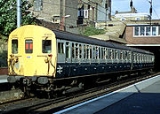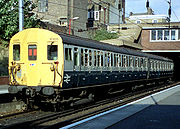
British Rail Class 416
Encyclopedia

British Rail
British Railways , which from 1965 traded as British Rail, was the operator of most of the rail transport in Great Britain between 1948 and 1997. It was formed from the nationalisation of the "Big Four" British railway companies and lasted until the gradual privatisation of British Rail, in stages...
Class 416 (2EPB) electric multiple unit
Electric multiple unit
An electric multiple unit or EMU is a multiple unit train consisting of self-propelled carriages, using electricity as the motive power. An EMU requires no separate locomotive, as electric traction motors are incorporated within one or a number of the carriages...
s were built between 1953 and 1956. They were intended for inner suburban passenger services on London's Southern Electric network. There were two subclasses of class 416: class 416/1 to an SR design on salvaged 2Nol underframes, and class 416/2 to BR's Mark I coach design.
In the 1980s some units were used on the North London Line
North London Line
The North London Line is a railway line which passes through the inner suburbs of north London, England. Its route is a rough semicircle from the south west to the north east, avoiding central London. The line is owned and maintained by Network Rail...
between Richmond
Richmond station (London)
Richmond station is a National Rail and London Underground station in the London Borough of Richmond upon Thames in south west London which is managed by South West Trains....
and North Woolwich
North Woolwich railway station
North Woolwich railway station in North Woolwich in east London was the eastern terminus of the North London Line. It was in Travelcard Zone 3. The next station was .-History:...
.
Tyneside units
Fifteen units built in 1954/5 to the BR Mark I coach design were built for the third rail electrified Tyneside Electric lines.They were built at Eastleigh, and were the last Tyneside third rail EMUs built. They followed the new British Railways standard design for suburban rolling stock: similar units were built at the same time for use on South London suburban routes, but the Tyneside units had features in keeping with previous Tyneside EMUs, such as a large brake van to accommodate a large volume of fish boxes and prams; electric headcode lights on the cab front between the windows; and above those a roller destination blind. Unlike units of this style built for service in the south, the Tyneside units had a single first class compartment.
The units operated the South Tyneside services between Newcastle Central and South Shields, a route that had a busy commuter frequency and passenger numbers to match. British Rail decided to withdraw electric traction from these routes and the South Tyneside route was the first to be replaced by diesel units, being de-electrified in 1963. All 15 units were re-allocated to South London, Kent, Surrey and Berkshire, which entailed some rebuilding of the cabs and the declassification of the first class compartment. The units continued in passenger service until 1985 when they were all withdrawn.
A number of units survived for a few years longer on non-passenger duties as test or tractor units. One was used for testing the Tonbridge - Hastings line electrification before the route was opened for electric trains in the summer of 1986. This unit also carried out similar work on the East Grinstead electrification two years later and saw occasional use on other test and tractor duties until laid up in 1995, by which time it was the only South Tyneside unit left. It was purchased for preservation by SERA and was moved to Robertsbridge in Sussex for initial restoration work, and moved to the Coventry Railway Centre in 1999.
The work of the association in restoring the unit back to its 'as built' condition is both costly and time-consuming but is being progressed by a dedicated team of SERA volunteers. It is hoped to bring the unit on a return visit to the North East when the restoration is completed. This unique survivor is a treasured example of a bygone age of suburban rail travel in the North East.
Rebuilds
The 416/1 subclass (5651-5684) was rebuilt at Eastleigh WorksEastleigh Works
Eastleigh Works is a locomotive, carriage and wagon building and repair facility in the town of Eastleigh in the county of Hampshire in England.-History under the LSWR:...
in 1959 using underframes from withdrawn SR Class 2NOL
SR Class 2Nol
The Southern Railway gave the designation 2-NOL to the electric multiple units built during the 1930s from old London and South Western Railway carriage bodies on new underframes...
units. The rebuilt units were initially classified 2NOP but later absorbed into the 2EPB classification. They had SR-designed bodies, similar to those of the earlier SR-design 4SUB
British Rail Class 405
Under the British Rail TOPS computer system, Class 415 was allocated to surviving examples of the Southern Railway 4-Sub Class electric multiple units built between 1941 and 1951...
units and Bulleid
Oliver Bulleid
Oliver Vaughan Snell Bulleid was a British railway and mechanical engineer best known as the Chief Mechanical Engineer of the Southern Railway between 1937 and the 1948 nationalisation, developing many well-known locomotives.- Early life and Great Northern Railway :He was born in Invercargill,...
locomotive-hauled coaching stock.
Electrical equipment
Each motor car had two 250 horsepowerHorsepower
Horsepower is the name of several units of measurement of power. The most common definitions equal between 735.5 and 750 watts.Horsepower was originally defined to compare the output of steam engines with the power of draft horses in continuous operation. The unit was widely adopted to measure the...
English Electric
English Electric
English Electric was a British industrial manufacturer. Founded in 1918, it initially specialised in industrial electric motors and transformers...
EE507 traction motor
Traction motor
Traction motor refers to an electric motor providing the primary rotational torque of a machine, usually for conversion into linear motion ....
s.
Unit numbers
- Class 416/1 Rebuilds, 5651-5684
- Class 416/2 New SR stock, 5701-5779
- Class 416/2 Former Tyneside stock, 5781-5795
Car numbers
- Tyneside stock:
- Motor cars, E65311-E65325
- Trailer cars, E77100-E77114
Preservation
The final units were withdrawn in 1995. Three units have been preserved, including an ex-Tyneside unit.| Unit number (current in bold) |
DMBSO | DTSso | Built | Livery | Location | ||
|---|---|---|---|---|---|---|---|
| 5667 | 6307 | - | 14573 | 16117 | 1959 Eastleigh | BR(S) Malachite Green | Electric Railway Museum, Baginton Coventry Railway Centre The Electric Railway Museum is located in Warwickshire, south of Coventry city, outside Baginton, and near to Coventry Airport. The heritage railway centre was also known as "The Airfield Line" as the railway was built on the site of a greenfield... |
| 5759 | 6259 | - | 65373 | 77558 | 1956 Eastleigh | BR Green | East Kent Railway East Kent Railway (heritage) The East Kent Railway is a short heritage railway in Kent, England. It is located at Shepherdswell station on the London to Dover Priory direct mainline. The line was constructed from 1911 to 1917 to serve a local colliery at Tilmanstone... |
| 5791 | 6291 | 932053 | 65321 | - | 1955 Eastleigh | Green primer / Blue grey | Electric Railway Museum, Baginton Coventry Railway Centre The Electric Railway Museum is located in Warwickshire, south of Coventry city, outside Baginton, and near to Coventry Airport. The heritage railway centre was also known as "The Airfield Line" as the railway was built on the site of a greenfield... |
| 5793 | 6293 | - | 77112 | ||||
Modelling
BachmannBachmann
Bachmann is a surname of Switzerland and Germany. It originates as a description of the bearer as dwelling near a brook , such as a farm "Hofstatt am Bach" also called "Bachmanns Hofstatt" near Hinwil or Dürnten , or the "Hof zum Bach" near Richterswil .Low German variants of the name include...
has announced that it will be releasing an 00 gauge model of a BR-design 2-EPB (416/2).

